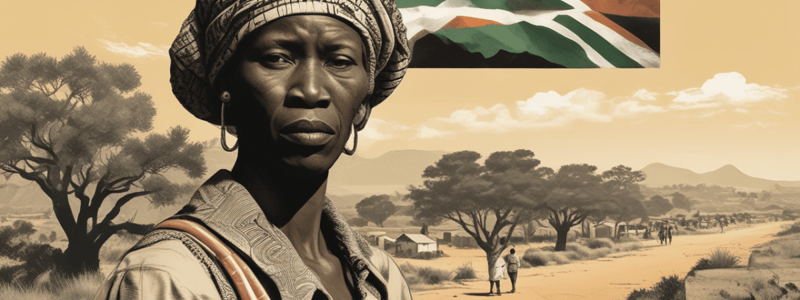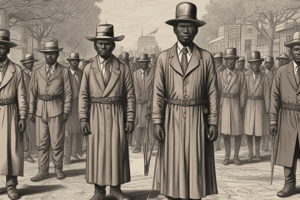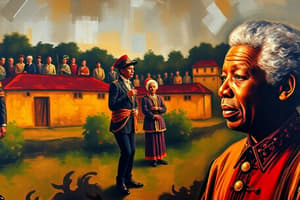Podcast
Questions and Answers
What percentage of South Africa's land was initially reserved for black South Africans according to the Natives Land Act of 1913?
What percentage of South Africa's land was initially reserved for black South Africans according to the Natives Land Act of 1913?
- 8% (correct)
- 5%
- 13%
- 20%
What was the result of the displacement of black South Africans from fertile land to overcrowded and less arable areas?
What was the result of the displacement of black South Africans from fertile land to overcrowded and less arable areas?
- They were able to maintain their livelihoods
- They were stripped of their land and livelihoods without compensation (correct)
- They received fair compensation for their land
- They were forced to work in mines and urban areas
What was the consequence of the migrant labor system developed as a result of the Natives Land Act?
What was the consequence of the migrant labor system developed as a result of the Natives Land Act?
- Strengthened traditional family structures
- Contributed to significant social strain (correct)
- Improved the living conditions of black South Africans
- Boosted the profitability of mines and farms owned by whites
What was the primary purpose of the Natives Land Act in relation to the mining industry?
What was the primary purpose of the Natives Land Act in relation to the mining industry?
Who documented the devastating effects of the Natives Land Act in his book?
Who documented the devastating effects of the Natives Land Act in his book?
What was the outcome of Sol Plaatje's efforts to resist the Natives Land Act?
What was the outcome of Sol Plaatje's efforts to resist the Natives Land Act?
What was the long-term consequence of the Natives Land Act of 1913?
What was the long-term consequence of the Natives Land Act of 1913?
What was the primary aim of the Natives Land Act in relation to black South Africans?
What was the primary aim of the Natives Land Act in relation to black South Africans?
What was the outcome of the institutionalized racism created by the 1913 Land Act?
What was the outcome of the institutionalized racism created by the 1913 Land Act?
What was the effect of economic marginalization on black South Africans?
What was the effect of economic marginalization on black South Africans?
What was the social consequence of the 1913 Land Act?
What was the social consequence of the 1913 Land Act?
What is the legacy of the 1913 Land Act?
What is the legacy of the 1913 Land Act?
What was the primary consequence of the 1913 Land Act on black South Africans?
What was the primary consequence of the 1913 Land Act on black South Africans?
How did the 1913 Land Act affect the economic lives of black South Africans?
How did the 1913 Land Act affect the economic lives of black South Africans?
What was a social consequence of the 1913 Land Act?
What was a social consequence of the 1913 Land Act?
What is a lasting impact of the 1913 Land Act on South African society?
What is a lasting impact of the 1913 Land Act on South African society?
What is a feature of the structured inequality created by the 1913 Land Act?
What is a feature of the structured inequality created by the 1913 Land Act?
What was the primary impact of the Natives Land Act of 1913 on the lives of black South Africans?
What was the primary impact of the Natives Land Act of 1913 on the lives of black South Africans?
What was the consequence of the forced labor and migration system developed as a result of the Natives Land Act?
What was the consequence of the forced labor and migration system developed as a result of the Natives Land Act?
What was the primary motivation behind the Natives Land Act's restriction on black South Africans' ability to sustain themselves independently through farming?
What was the primary motivation behind the Natives Land Act's restriction on black South Africans' ability to sustain themselves independently through farming?
What was the significance of Sol Plaatje's book 'Native Life in South Africa'?
What was the significance of Sol Plaatje's book 'Native Life in South Africa'?
What was the ultimate consequence of the Natives Land Act's institutionalization of racial segregation?
What was the ultimate consequence of the Natives Land Act's institutionalization of racial segregation?
What was the impact of the Natives Land Act on the traditional family structures of black South Africans?
What was the impact of the Natives Land Act on the traditional family structures of black South Africans?
What was the primary goal of the Natives Land Act in relation to the land ownership of black South Africans?
What was the primary goal of the Natives Land Act in relation to the land ownership of black South Africans?
What was the ultimate outcome of the Natives Land Act's restriction on black South Africans' ability to sustain themselves independently through farming?
What was the ultimate outcome of the Natives Land Act's restriction on black South Africans' ability to sustain themselves independently through farming?
What is the primary way in which the 1913 Land Act created a structured inequality?
What is the primary way in which the 1913 Land Act created a structured inequality?
What is the primary consequence of the economic marginalization of black South Africans under the 1913 Land Act?
What is the primary consequence of the economic marginalization of black South Africans under the 1913 Land Act?
What is the primary social consequence of the 1913 Land Act?
What is the primary social consequence of the 1913 Land Act?
What is the primary legacy of the 1913 Land Act?
What is the primary legacy of the 1913 Land Act?
What is the primary period during which the effects of the 1913 Land Act were felt?
What is the primary period during which the effects of the 1913 Land Act were felt?
What was the primary mechanism by which the Natives Land Act of 1913 facilitated the exploitation of black South Africans?
What was the primary mechanism by which the Natives Land Act of 1913 facilitated the exploitation of black South Africans?
What was the significance of the 13% of the country's land reserved for black South Africans?
What was the significance of the 13% of the country's land reserved for black South Africans?
What was the primary consequence of the displacement of black South Africans from their agricultural base?
What was the primary consequence of the displacement of black South Africans from their agricultural base?
What was the role of Sol Plaatje in the resistance against the Natives Land Act?
What was the role of Sol Plaatje in the resistance against the Natives Land Act?
What was the ultimate consequence of the Natives Land Act's institutionalization of racial segregation?
What was the ultimate consequence of the Natives Land Act's institutionalization of racial segregation?
What was the impact of the migrant labor system on traditional family structures?
What was the impact of the migrant labor system on traditional family structures?
What was the primary motivation behind the Natives Land Act's restriction on black South Africans' ability to sustain themselves independently through farming?
What was the primary motivation behind the Natives Land Act's restriction on black South Africans' ability to sustain themselves independently through farming?
What was the significance of the Natives Land Act in the context of South African history?
What was the significance of the Natives Land Act in the context of South African history?




